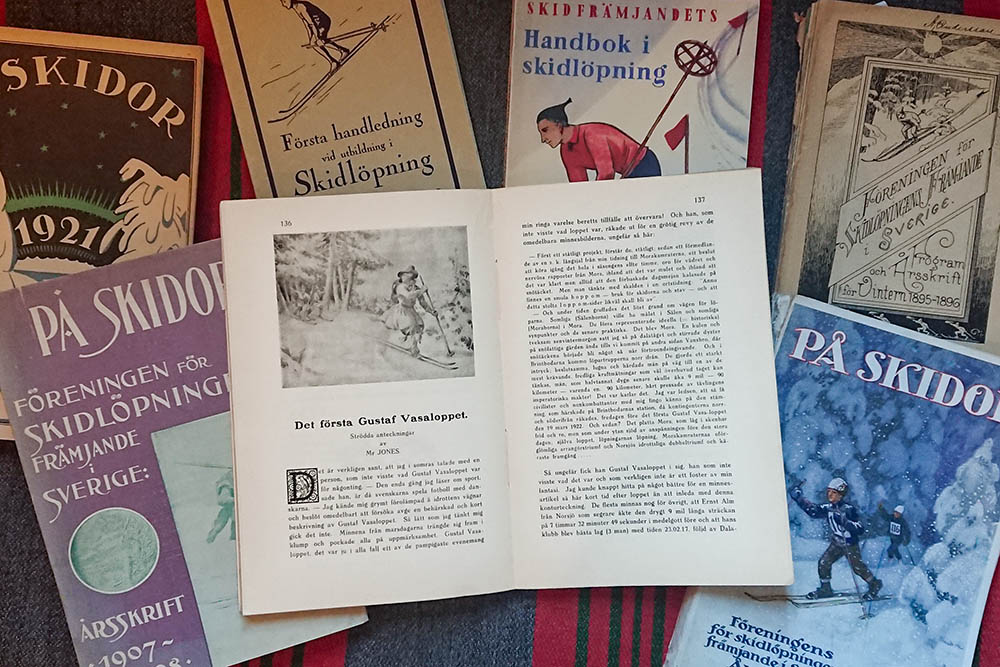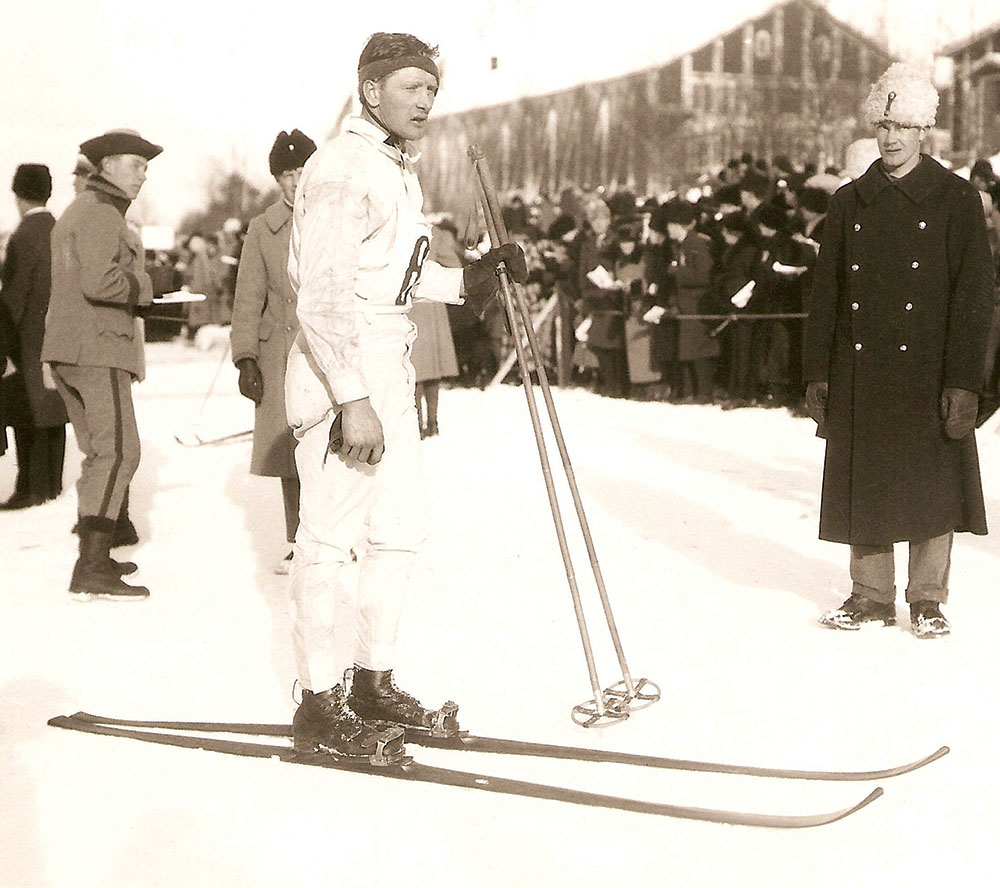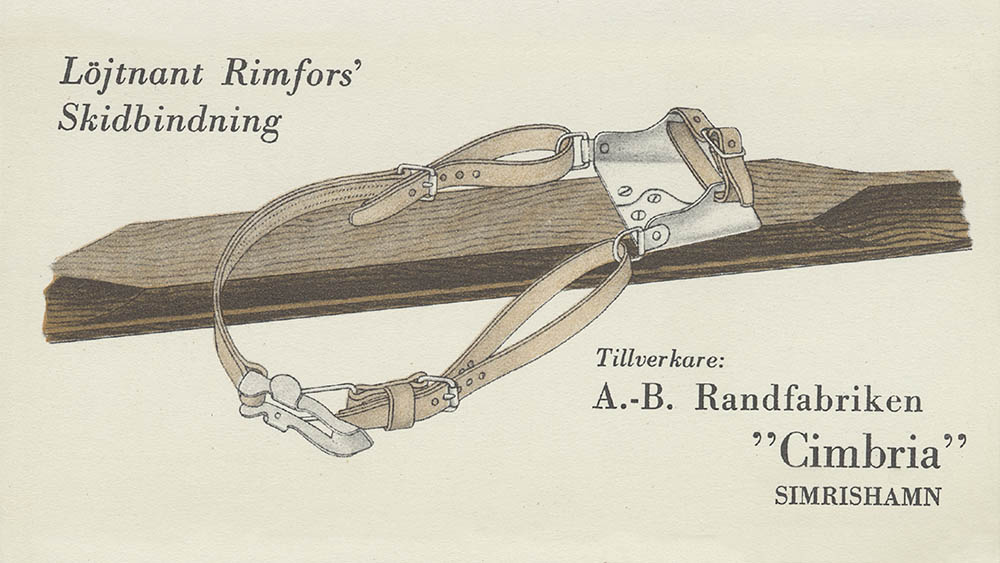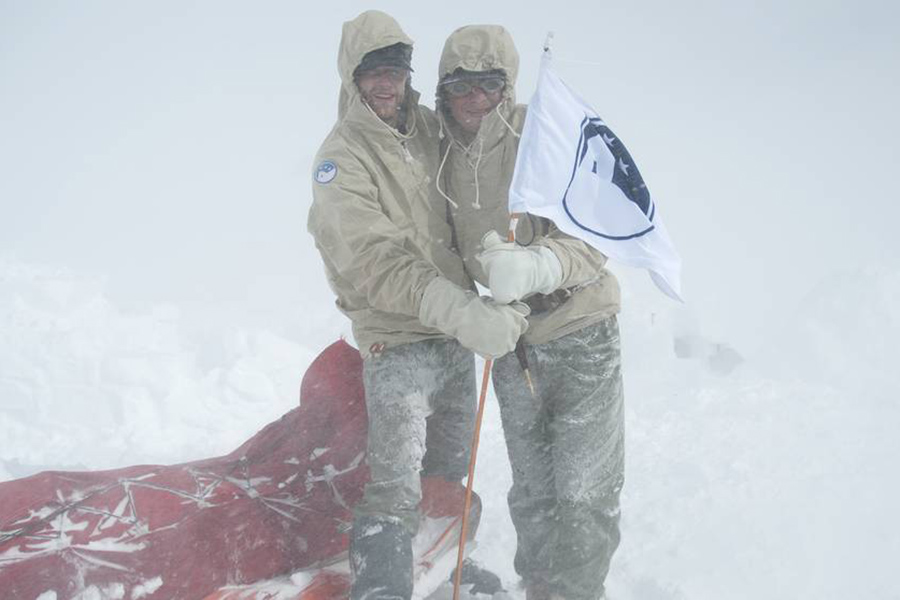C like in century. Next year will be a hundred years since the polar explorer Fridtjof Nansen was awarded the Nobel Peace Prize for his humanitarian and peace-building efforts within the League of Nations, the forerunner of the UN. In the same year, 1922, Randfabriken Cimbria Inc of Simrishamn launched my great-grandfather’s first ski binding: Lieutenant Rimfors’ model. He was one of the millions who, since childhood, had been inspired by Nansen’s captivating expeditions on skis across Greenland and towards the North Pole. Although the Norwegian polar hero was awarded for helping stateless refugees obtain their “Nansen Passports” after the First World War, his biggest legacy is, of course, that recreational skiing spread across the world. Suddenly, skiing was no longer just a means of transport for Norwegians, Sami and settlers in the northernmost Nordic countries.
1922 was also the year when editor-in-chief Anders Pers of the newspaper Vestmanlands Läns Tidning asked: “Why can we not take up Mora–Sälen as a national ski race, take it up right now, as we best celebrate the 400th anniversary of Gustaf Eriksson’s liberation endeavors.” The day after this article appeared in VLT, my great-grandfather’s igloo buddy, Mr Jones,* picked up the idea in the national paper Dagens Nyheter: “What does the Swedish Ski Association say? Here are opportunities to institute a classic race!” After that, the media fell silent. Then, three weeks later, Mr Jones received a paper clipping from Mora Tidning announcing that IFK Mora had declared itself ready to “take on the race if only a sum of one thousand Swedish kronor could be raised to cover the costs.”
As chief editor for the sport pages at DN—where, two years earlier he had revolutionized sports journalism with the first daily collected sports page in the Swedish press—David “Mr Jones” Jonason promised the following day to donate the thousand kroner to the Mora sports club in order to carry out the competition. The media awoke and got cracking. Within two weeks, “Sweden’s real marathon run, Sweden’s Holmenkollen race, a classic and historical competition, the Swedish people’s contest” was organized. The rest is history.
Next year, an entire century will have passed since the very first Vasaloppet race, or “Gustaf Vasaloppet”, as Mr Jones and several others called it. However, as you all know, the route was from Sälen to Mora instead. It has also been half a millennium (plus one year in February) since the head of state at the time, Gustav Eriksson, later King Gustav Vasa, traveled through the Dala forests in order to recruit the Dalecarlians to help him in the rebellion against the Danish king, so that Sweden could leave the Scandinavian Kalmar Union.
* Mr Jones about The first Gustav Vasaloppet in Skidfrämjandet’s yearbook På skidor 1923 (PDF in Swedish)
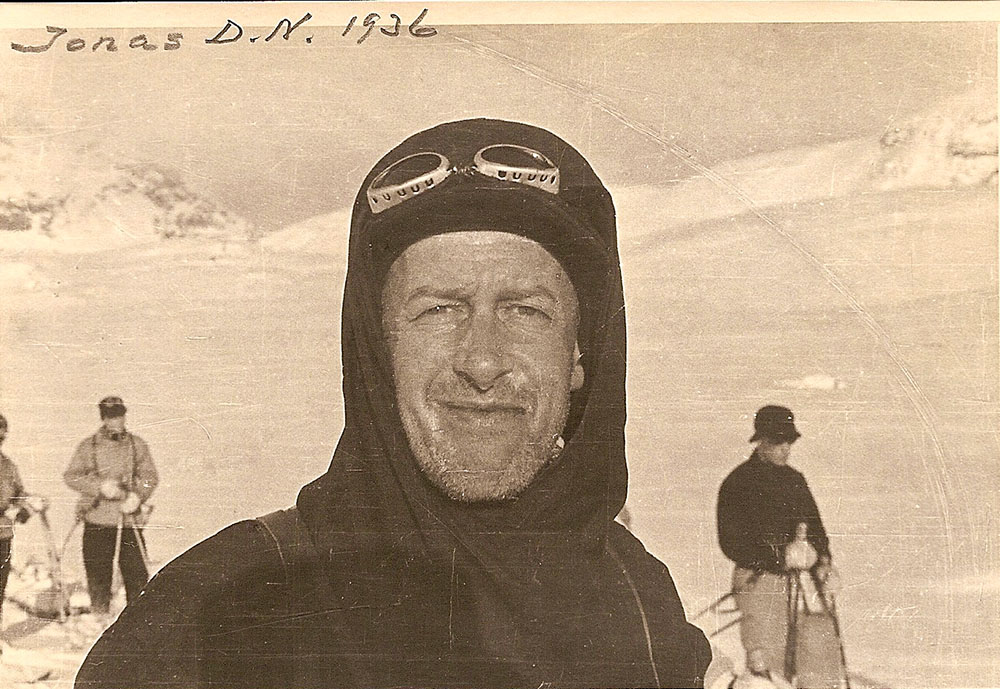

Old ski equipment and weakened materials
Ski bindings were not the only thing my great-grandfather developed for skiing. He rationalized the ski waxing methodology by creating a coherent system with his innovative waxing chart, developed ski waxes for all snow conditions, expedition pulks for long ski tours, slalom skis, and of course, bamboo ski poles. The Rimfors poles from the 1930s are one of the reasons I started making ski poles myself. Since there are not many who make ski poles with bamboo anymore, many of the contestants for the anniversary heritage Vasaloppet race, called Jubileumsvasan, have contacted me to help them with the construction of traditional 1920s style ski poles. Amongst them are two of my friends who will cross country ski the ninety kilometers between Sälen and Mora using vintage tar-waxed wooden skis and long poles with heavy leather baskets. Therefore, I have renovated two pairs of old bamboo poles for them.
I myself have made the mistake of going on a week-long expedition in the mountains in the old style without replacing certain materials and components of the aged equipment. During an igloo expedition through the Marsfjällen mountains, first one of my pole straps broke, unfortunately during the ascent from Marsliden, then one of the leather baskets also came off, and eventually the leather grips deteriorated under my drenched woolen mittens. It was with a lot of effort and great difficulty that I progressed with my igloo pals to the final night and welcoming committee in Kittelfjäll.
Very old skis and poles should not be taken out on long journeys without checking them thoroughly. Wood contains lignin. It is the lignin that makes wood hard and resilient. Over time, the lignin breaks down and the wood dries out and becomes fragile. Raw linseed oil can rejuvenate wood by replacing lignin, and can be applied—mixed with an equal amount of balsam turpentine—to soak in and give new strength. For my own part, I would still never head out for a long journey into the wilderness with a pair of hundred years old skis or bamboo poles. It is impossible to know whether the weakened wood or leather will hold up or not.
Traditional old bamboo ski poles are relatively plentiful. But if you have to push yourself ninety kilometers between Sälen and Mora, I strongly recommend renovating the poles first. Here is a guide of how to renovate a pair of vintage ski poles yourself.
Renovating old bamboo ski poles—DIY guide
Materials
- 1 pair of old bamboo sticks with leather baskets (you only need the aluminum ferrules, ski tips and rattan rings)
- 2 canes of Tonkin bamboo (of your own height—available in all garden stores and DIY stores)
- Pine dowel rod
- Wood glue
- 2 flat head copper rivets + washers (4×32 mm)
- 2 split pins/cotter pins + washers (3,2×36 mm)
- 8 rivets
- Double-sided tape
- Leather or contact a saddler
- Leather conditioner
Tools
- Side cutter
- Needle-nose pliers
- Wooden mallet
- Hammer
- Japanese saw
- Vice
- Screw gun + drill bits
- Leather tools: scissors, knife, leather punch, metal ruler, curved needle, thread, or a saddler
Time needed: 5 hours
Description step by step
- Remove old baskets
Remove the old basket by pulling or cutting off the split pin that sits through the ferrule. Then pry off the baskets and leather fastener.
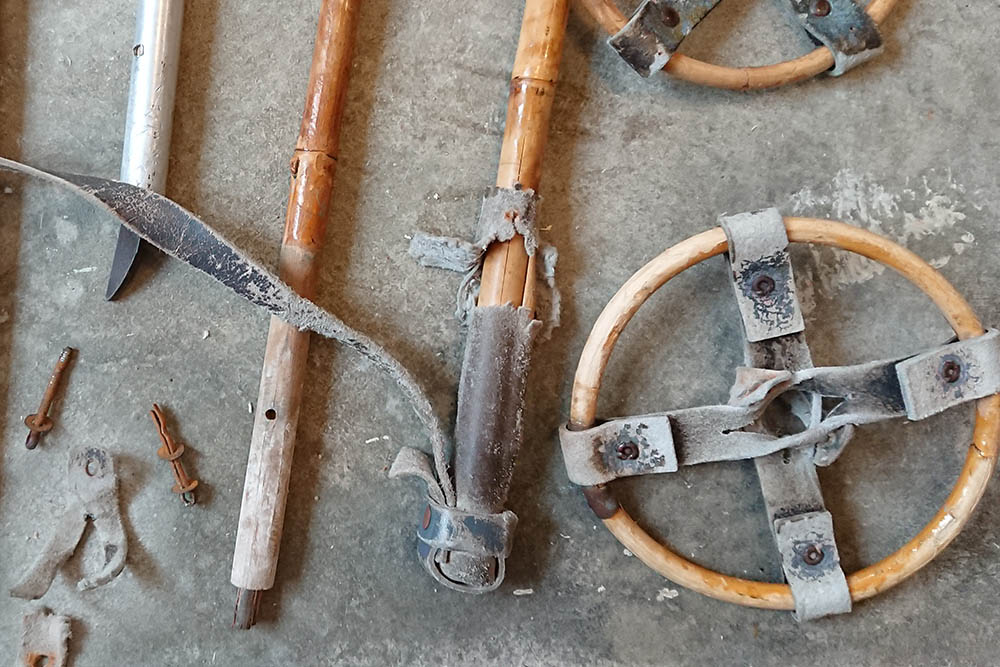
- Remove ferrule and tips
Flat tip: If it is a flat ski tip: pry off the ferrule and ski tip. In my case, I had to fasten the tip in a vise and pull the bamboo stick.
Screw tip: If it is a “three-dimensional” threaded screw-on ski tip, simply unscrew it and pry the ferrule off.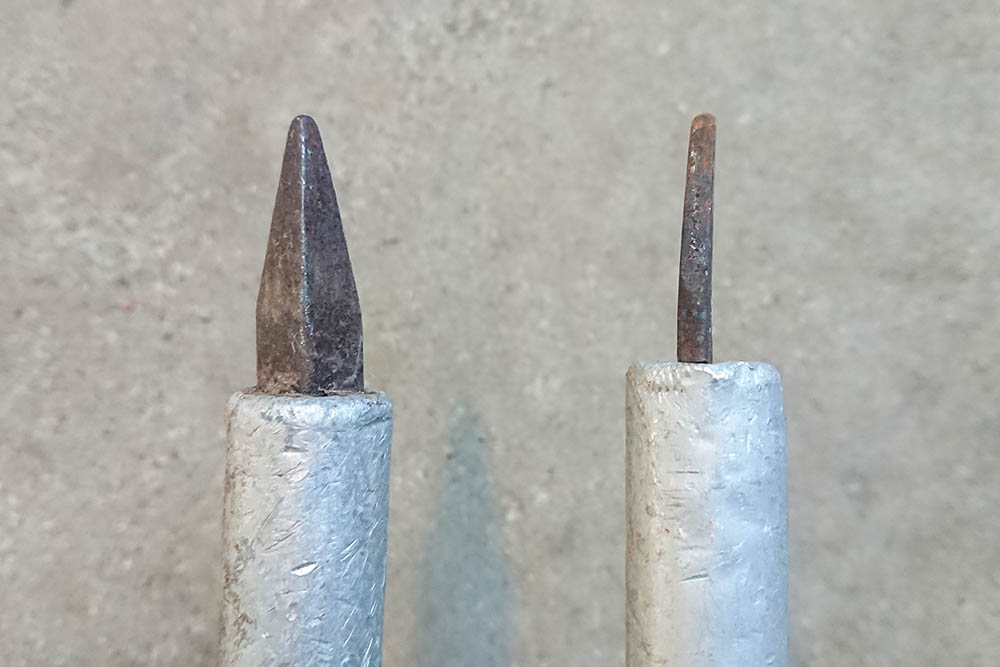
- Match the bamboo cane and ferrule
If the old bamboo cane is too short or damaged, you need to replace it with a new one. The diameter of the bamboo cane at the thin end (closest to the snow) should match the diameter of the ferrule. If it doesn’t, sand down the bamboo until it fits all the way to the bottom of the ferrule.
- Plug the lower end and mount ferrule and tip
Plug the lower thin end of the bamboo with a pine dowel. If necessary, sand the pine dowel so that it goes into the hollow without too much force, and then attach the dowel with wood glue.
Flat tip: For a flat ski tip, drill several holes into the plugged end so that the flat tip can be tapped into the rectangular slot, but before tapping the tip, pry on the ferrule.
Screw tip: For threaded screw version ski tip, you simply drill a centered hole in the plugged end, pry on the ferrule and screw the tip onto the end.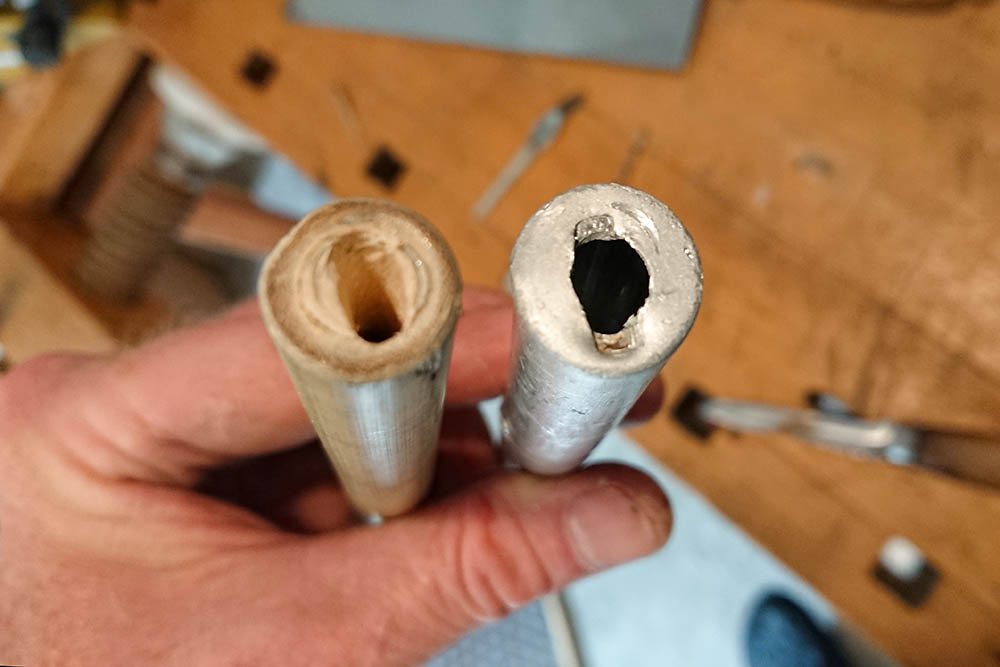
- Cut off bamboo
Cut off the bamboo canes so that they are approximately at your shoulder height. Use a fine-toothed saw or Japanese saw to keep the cut clean.

- Plug the upper end
Plug the thick upper end in the same manner as before.

- Measure and cut leather for baskets
I recommend a saddler for this step! Use the leather from the old baskets to measure and cut out new leather of the right thickness and quality. For the baskets we used 2.5 mm thick leather. Then rivet the leather to the rattan/wicker rings and mount the baskets using the fastening leather straps and split pins with washers. I used a Ø3.5 mm drill bit for the split pin hole.
Download template for measuring and cutting out leather for Ø150 mm baskets here!
If you prefer to buy a ready-made leather kit, you find info below.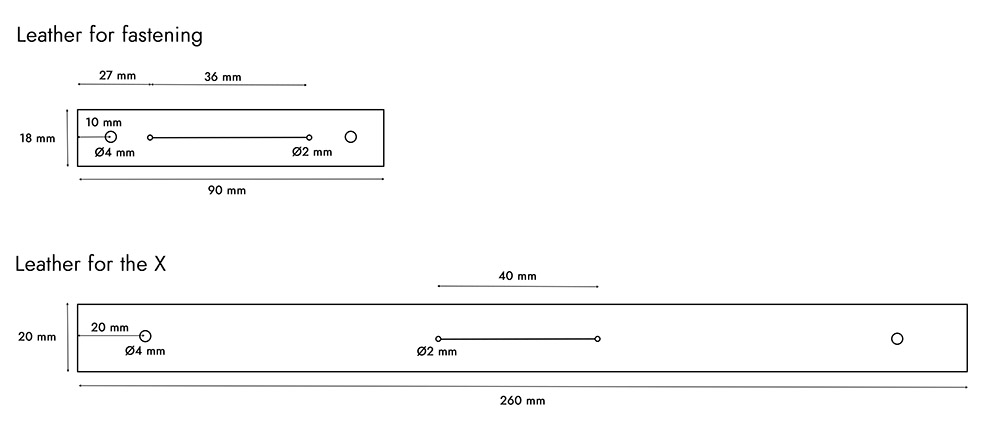
- Measure and cut out leather for the grips
I recommend a saddler for this step! Grips were often very long and also the pole straps. Mark on the bamboo how far down the grips should go and put double-sided adhesive tape where the handles will sit. Sew on the leather with either an external seam or a hidden “invisible stitch”. We used think leather for the grips. Keep in mind that the seam should be on the back of the grips, but it should not get in the way of the bore hole you need to drill later for the pole strap. Note! Not everyone had grips on their poles in the 1920s and earlier, and thus not always straps either, but most who competed regularly had it.
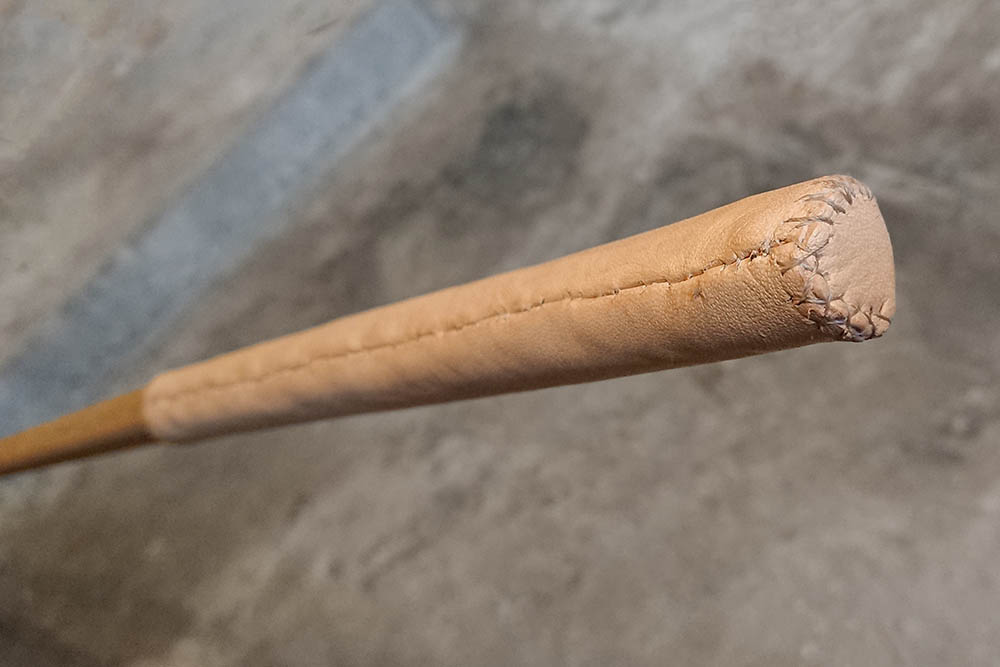
- Nourish the leather
Nourish all leather properly with leather conditioner before everything is mounted, but not too much on the grip, as the leather there may absorb enough to affect the grip of the tape underneath.
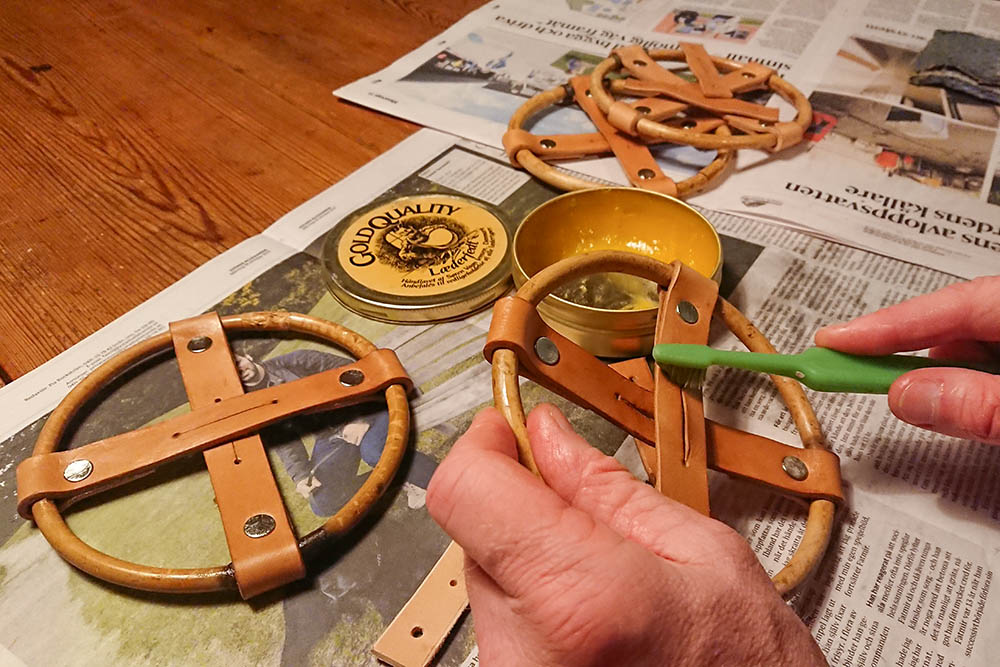
- Measure for pole straps
Measure how long pole straps you need. In the picture below you can see how it will lie over the bamboo. This way you can measure how long it needs to be for you to get your hand grip at the height you want. We used 2.5 mm thick leather for the straps and made them 18 mm wide and 500 mm long.
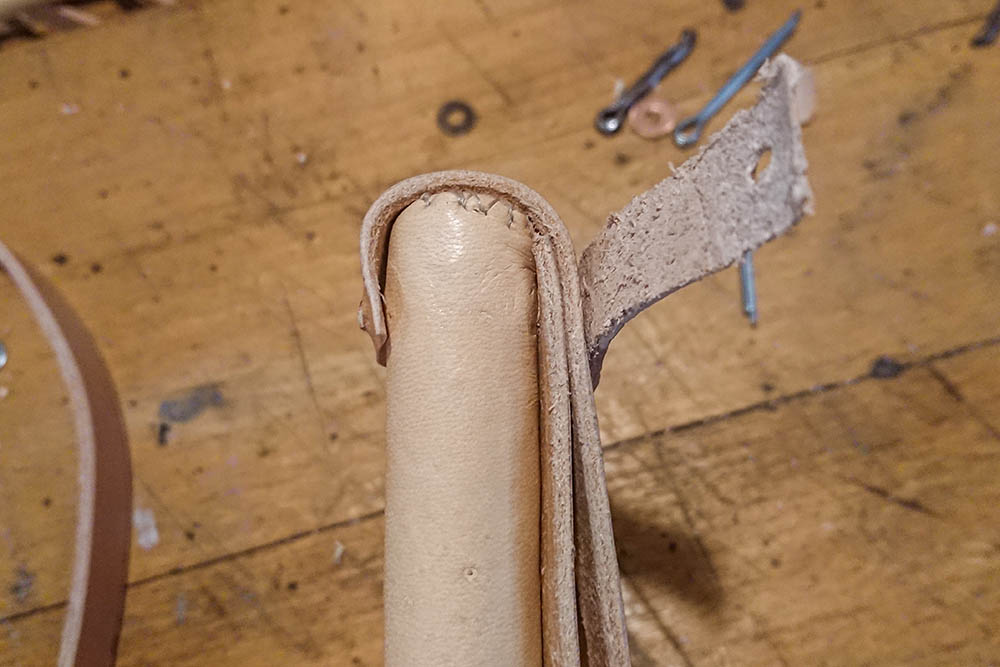
- Drill for rivet and pole strap
Drill a hole through the grip and bamboo where the copper rivet will go, but beware of the seam! I used a Ø4.5 mm drill bit.
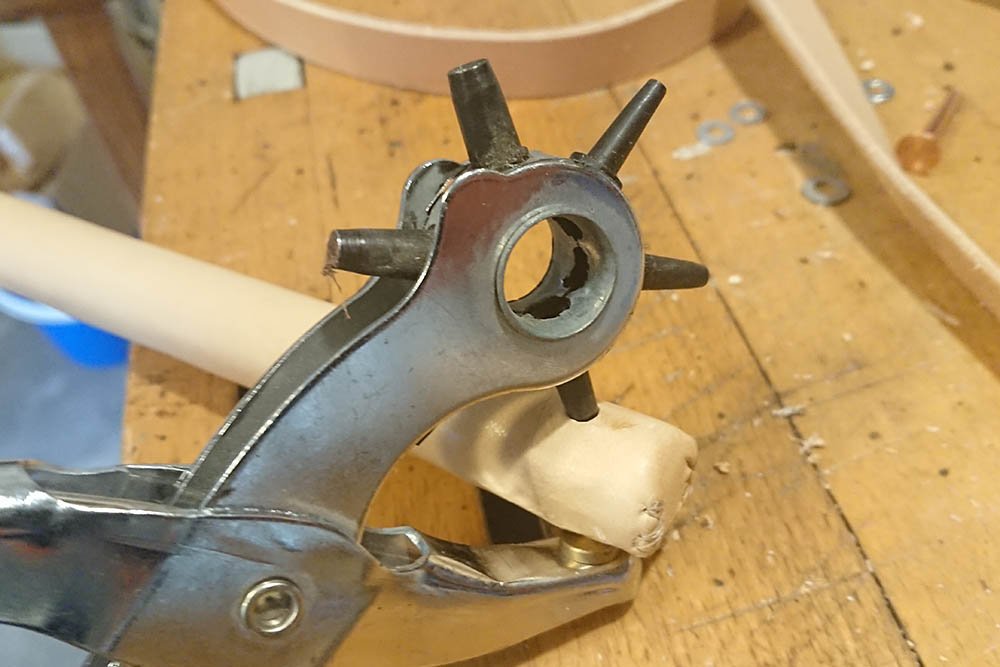
- Holes for rivet on the strap
Make a hole with a leather punch in the pole strap where the copper rivet should pass. On the reinforcement band, first make a hole in the end that is attached first, ie on the “front” of the pole (at the far right in the picture below). Then you insert the copper rivet from the wrong direction, ie “from the front”. Pull the reinforcement band and press it over the tip of the rivet to mark where to punch the second hole. After making hole number two, turn the copper rivet again and repeat the procedure for the third (last) hole that seals everything on the “front”.

- Mount the strap
Mount the pole strap together with a leather reinforcement band, around both the grip and the strap, and seal everything with the copper rivet. Often, both then and now, you turn the strap half a turn so that it does not fold against the wrists. See photos further down of how it used to be turned and attached. Have some extra reinforcement band so that you have something to pull with as you fit the rivet into the hole, like the image just below. Note! The washer goes on the front side.

- Hammer the rivet
The washer goes on the front. The head is the strongest, therefore it sits on the back to hold the hand strap in place. Finally, hammer the copper rivet and washer around everything. Note! Don’t hammer from straight above. Hammer the copper rivet from a slight angle, so that the copper expands around the hole of the washer.
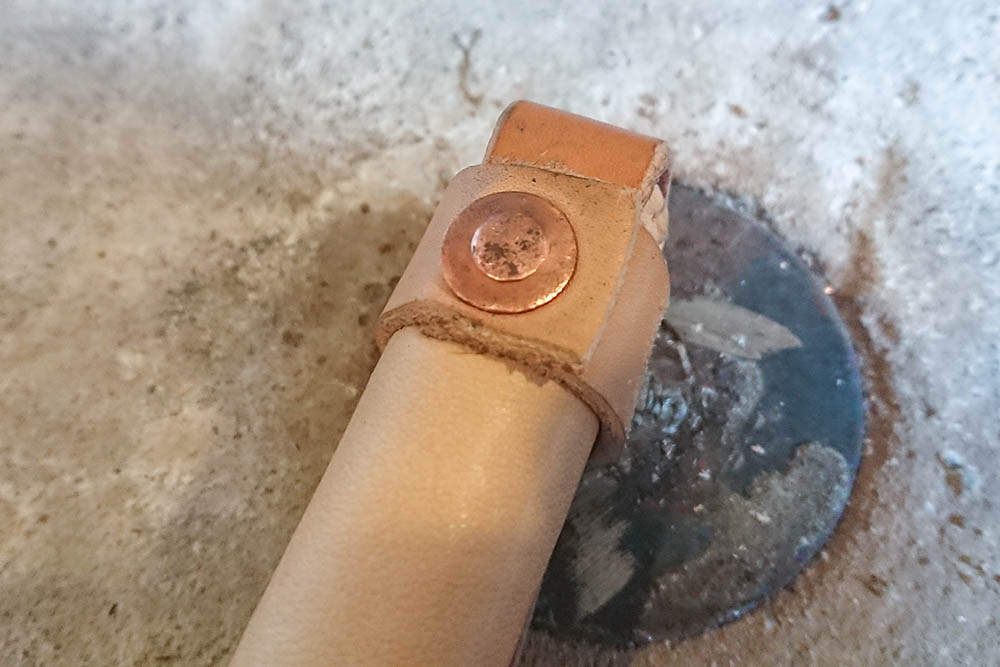
- Done diddly done!
Congratulations to your 100th anniversary Vasaloppet ski poles!
Note! Remember not to expose bamboo poles to strong and rapid heating. Then they can crack! I usually recommend polishing bamboo sticks once a year with linseed oil wax, and in this case it would probably be good to also oil the rattan rings with equal amounts raw linseed oil and turpentine.
With the help of this do-it-yourself description and attached pictures, I hope that anyone who desire can renovate a couple of old ski poles so that they become functional as new again. If your old bamboo poles are long enough, you don’t really need to replace the bamboo canes. There are often cracks on old bamboo, caused by temperature change or dry storing conditions, but it is with these as with the oak beams in the ceiling: a longitudinal crack is usually nothing to worry about.
My first traditional style bamboo ski poles
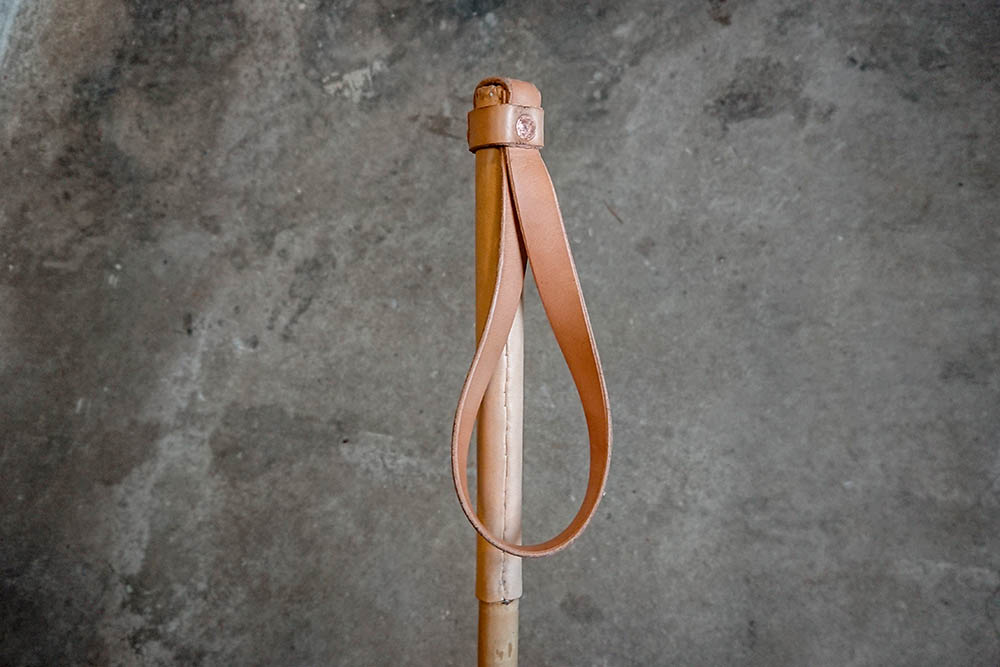

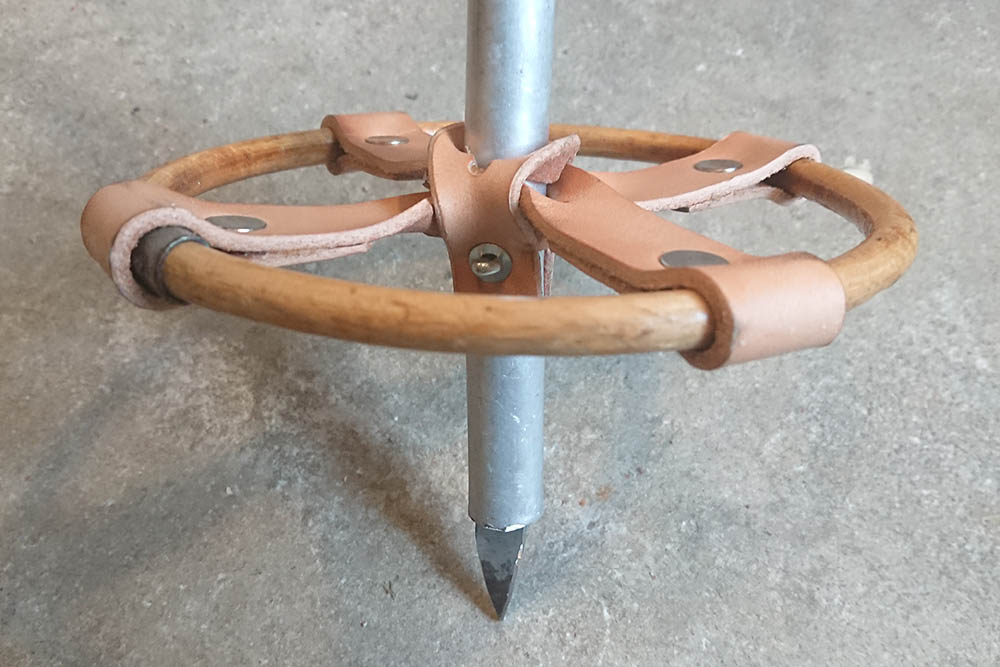
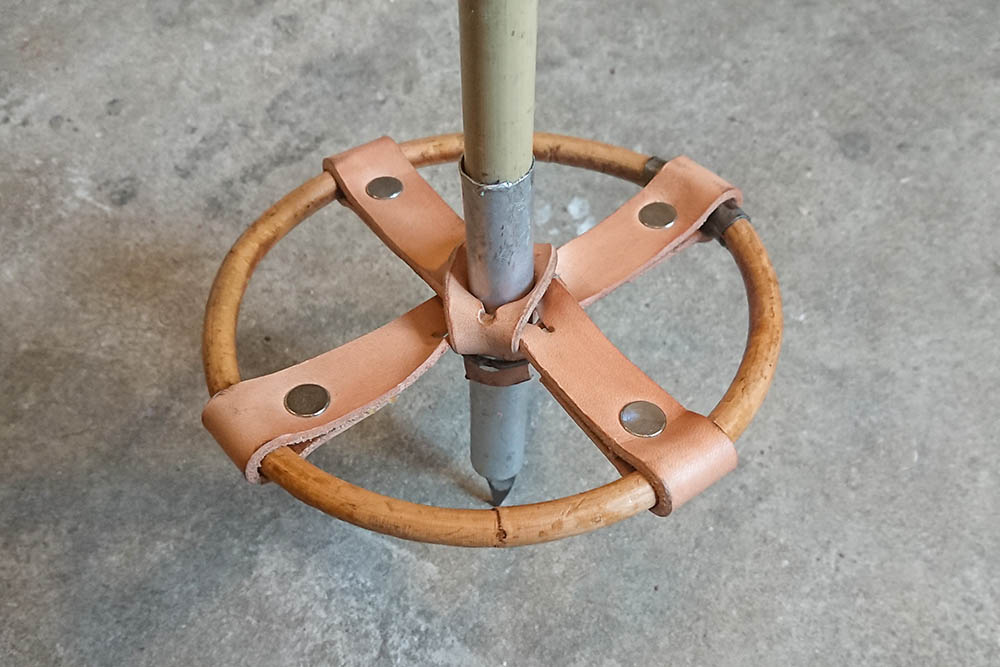
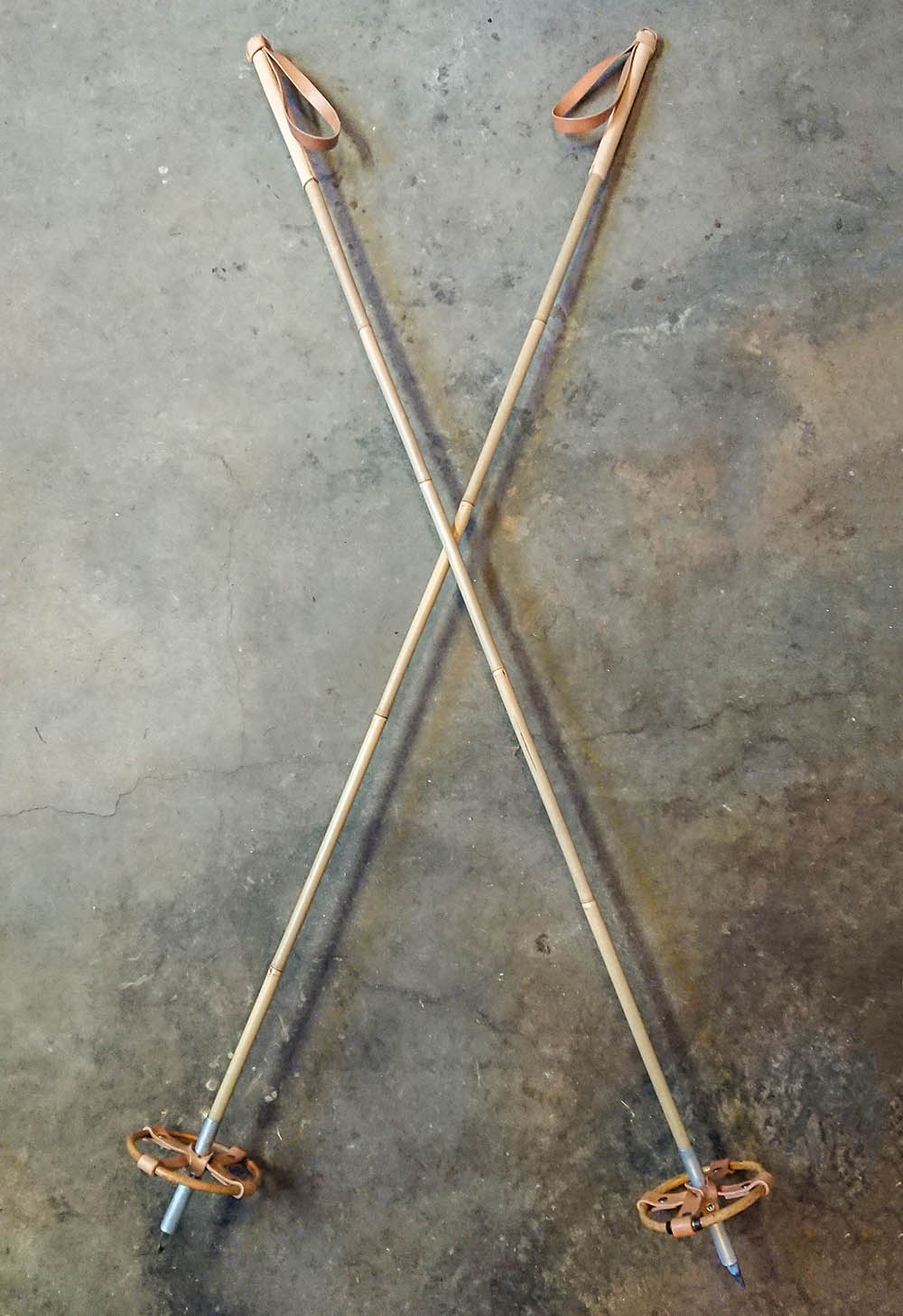
Buying materials to renovate old bamboo ski poles
Leather kit for bamboo ski poles
The saddler and upholsterer Bodil, who picked and cut out leather for the poles I renovated for my friends, sells ready-made kits with cut-out leather of the right dimensions. You get the adequate thickness and quality of the different pieces of leather. She needs to know the diameter of your rattan rings and exactly how long the grips should be.
Leather kit 220 SEK + shipping
Contains leather for baskets and fastening, grips, pole straps, reinforcement bands, as well as rivets, curved needle and thread. Contact Bodil’s Tapetserarbod (upholstery workshop)
Bamboo
Tonkin bamboo (Pseudosasa amabilis) became the dominating ski pole shaft from the 1920s and onwards. Other varieties of bamboo were still used, but were soon totally replaced by Tonkin. You find Tonkin canes in pretty much in all garden and hardware stores. Bring the ferrules with you for reference when you shop for bamboo. Around Ø17 mm at the upper end by the grip and around Ø15 mm at the lower end by the basket usually work well. Pick bamboo canes with thick cell walls. It’s a little heavier but more durable.
Copper rivet
Flat head copper rivets of the right dimension were difficult to obtain. I bought a 10-pack with 4×32 mm. They were almost too short, but I eventually managed to knock on the washer and secure the strap. To avoid buying hundreds of copper rivets, I bought from Hockeyverkstan.

Equipment in the good ol’ days
I will not be long-winded and go into old equipment too much. But I have some general tips that can be useful for those lucky ones going to ski the Jubileumsvasan. My first tip is: be consistent! Don’t dress like a rapper below and a rocker on your upper body. Stick to the socio-economic class you intend to represent in the race. Otherwise, it can be comical. In other words: tweed knickers paired with a worn-out lumberjack shirt may not be the best combination. Just because both occurred among skiers in the 1920s does not mean that a skier combined these two garments. Be strict!
So, what were they wearing back then? Many of you probably know this already, but for those of you who want to immerse yourselves, I recommend looking in old handbooks and Skidfrämjandet’s (current Friluftsfrämjandet) yearbooks on skis. There you find both reviews and advertisements that tell how they reasoned about equipment and which models existed.
PRV’s (Swedish Intellectual Property Office) searchable patent database is also a very good source to see whether the equipment you are thinking of existed or not in 1922. There are, for example, plenty of ski bindings (formerly often called “skidbindsle” in Swedsih) with both toe iron and tightener from the late 19th century until 1920s. Under “advanced search” you can search from 1922 and back in time.
I have one chapter each from two historically important handbooks. The first is a one-page chapter only, dated 1922, from the book Första handledning vid utbildning i skidlöpning (First guide to ski training) by the ski promoter Victor von Feilitzen. The second is admittedly from 1931, but most of it is perfectly in line with how it was in 1922. The book is called Handbok i skidlöpning (Handbook to skiing), written by my great-grandfather and his partner Gunnar Dyhlén. The chapter on equipment is a full 28 pages and deals with everything from how the wooden log should be cut up to make skis to what clothes to wear for competition.
- Första handledning vid utbildning i skidlöpning, by Victor von Feilitzen, 1922 (PDF in Swedish)
- Handbok i skidlöpning – Del 1: Terränglöpning, by Olle Rimfors och Gunnar Dyhlén, 1931 (PDF in Swedish)
- Nordisk Familjeboks sportlexikon – History of ski bindings, 1946 (PDF in Swedish)
I’m happy that old vintage equipment and natural materials get highlighted thanks to Jubileumsvasan. Natural materials are often superior to many modern materials. In addition, natural materials often work well in a circular and climate-smart economy. Personally, I hope that the Jubileumsvasan will be a permanent feature in the Vasaloppet program. Who wouldn’t want to ski the “Original vasa” and feel the echoes of history?
Go for it and good luck!
Fabian Rimfors
P.S. If you’re interested in building a pair of modern touring or alpine ski poles, you find a DIY guide here!
